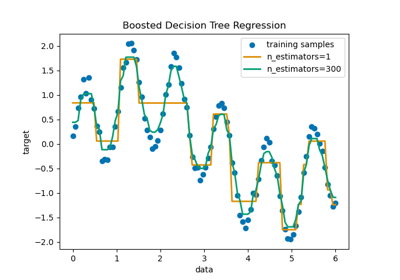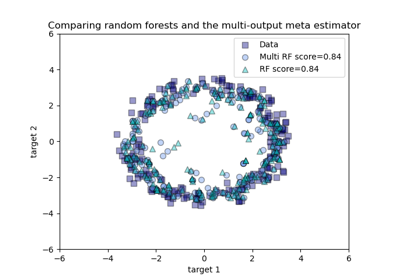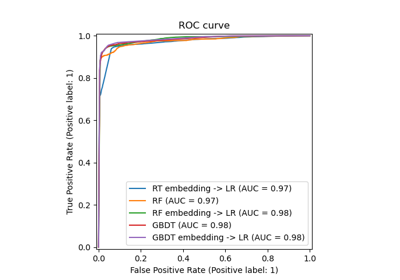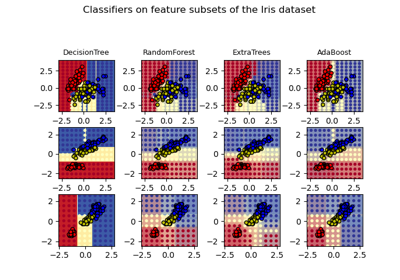注意
转到末尾以下载完整示例代码或通过 JupyterLite 或 Binder 在浏览器中运行此示例。
决策树回归#
在此示例中,我们演示了更改决策树的最大深度对其拟合数据的影响。我们分别在 1D 回归任务和多输出回归任务上执行此操作。
# Authors: The scikit-learn developers
# SPDX-License-Identifier: BSD-3-Clause
1D 回归任务上的决策树#
在这里,我们在 1D 回归任务上拟合一棵树。
决策树用于拟合具有附加噪声观测值的正弦曲线。因此,它学习近似正弦曲线的局部线性回归。
我们可以看到,如果树的最大深度(由 max_depth 参数控制)设置得太高,决策树会学习训练数据过于精细的细节并从噪声中学习,即它们会过拟合。
创建随机 1D 数据集#
import numpy as np
rng = np.random.RandomState(1)
X = np.sort(5 * rng.rand(80, 1), axis=0)
y = np.sin(X).ravel()
y[::5] += 3 * (0.5 - rng.rand(16))
拟合回归模型#
在这里,我们拟合两个具有不同最大深度的模型
from sklearn.tree import DecisionTreeRegressor
regr_1 = DecisionTreeRegressor(max_depth=2)
regr_2 = DecisionTreeRegressor(max_depth=5)
regr_1.fit(X, y)
regr_2.fit(X, y)
预测#
获取测试集上的预测
X_test = np.arange(0.0, 5.0, 0.01)[:, np.newaxis]
y_1 = regr_1.predict(X_test)
y_2 = regr_2.predict(X_test)
绘制结果#
import matplotlib.pyplot as plt
plt.figure()
plt.scatter(X, y, s=20, edgecolor="black", c="darkorange", label="data")
plt.plot(X_test, y_1, color="cornflowerblue", label="max_depth=2", linewidth=2)
plt.plot(X_test, y_2, color="yellowgreen", label="max_depth=5", linewidth=2)
plt.xlabel("data")
plt.ylabel("target")
plt.title("Decision Tree Regression")
plt.legend()
plt.show()
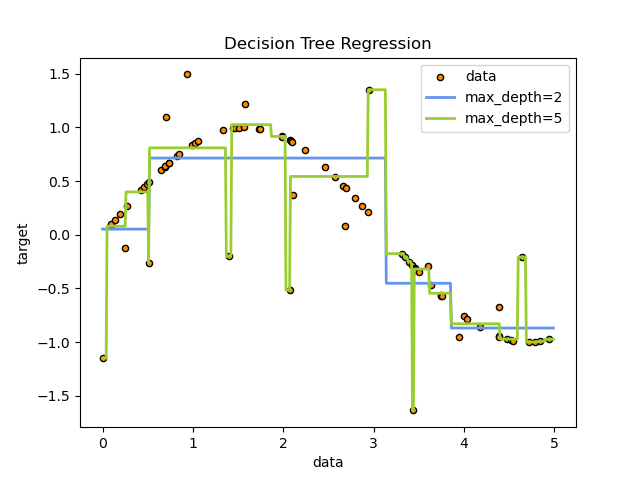
如您所见,深度为 5 的模型(黄色)学习了训练数据的细节,以至于它对噪声过拟合。另一方面,深度为 2 的模型(蓝色)很好地学习了数据的主要趋势,并且没有过拟合。在实际用例中,您需要确保树不会对训练数据过拟合,这可以通过交叉验证来完成。
具有多输出目标的决策树回归#
在这里,决策树用于同时预测给定单个基础特征的圆的噪声 x 和 y 观测值。因此,它学习近似圆的局部线性回归。
我们可以看到,如果树的最大深度(由 max_depth 参数控制)设置得太高,决策树会学习训练数据过于精细的细节并从噪声中学习,即它们会过拟合。
创建随机数据集#
拟合回归模型#
regr_1 = DecisionTreeRegressor(max_depth=2)
regr_2 = DecisionTreeRegressor(max_depth=5)
regr_3 = DecisionTreeRegressor(max_depth=8)
regr_1.fit(X, y)
regr_2.fit(X, y)
regr_3.fit(X, y)
预测#
获取测试集上的预测
X_test = np.arange(-100.0, 100.0, 0.01)[:, np.newaxis]
y_1 = regr_1.predict(X_test)
y_2 = regr_2.predict(X_test)
y_3 = regr_3.predict(X_test)
绘制结果#
plt.figure()
s = 25
plt.scatter(y[:, 0], y[:, 1], c="yellow", s=s, edgecolor="black", label="data")
plt.scatter(
y_1[:, 0],
y_1[:, 1],
c="cornflowerblue",
s=s,
edgecolor="black",
label="max_depth=2",
)
plt.scatter(y_2[:, 0], y_2[:, 1], c="red", s=s, edgecolor="black", label="max_depth=5")
plt.scatter(y_3[:, 0], y_3[:, 1], c="blue", s=s, edgecolor="black", label="max_depth=8")
plt.xlim([-6, 6])
plt.ylim([-6, 6])
plt.xlabel("target 1")
plt.ylabel("target 2")
plt.title("Multi-output Decision Tree Regression")
plt.legend(loc="best")
plt.show()
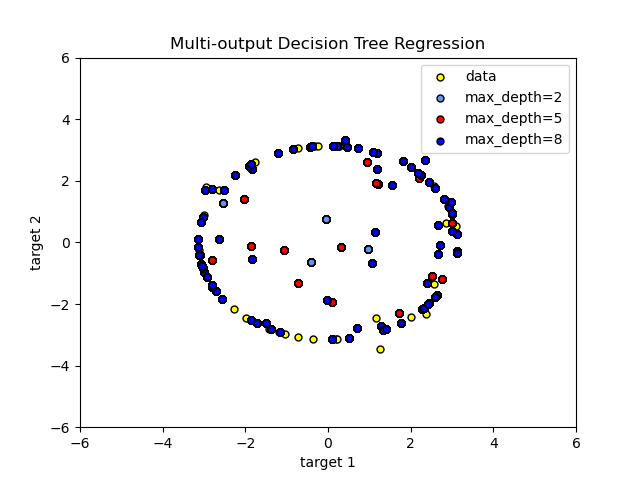
如您所见,max_depth 的值越高,模型捕获的数据细节越多。然而,模型也会对数据过拟合并受到噪声的影响。
脚本总运行时间: (0 分钟 0.290 秒)
相关示例
